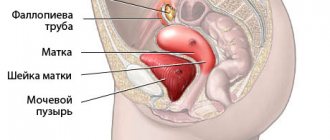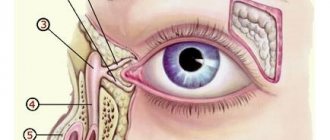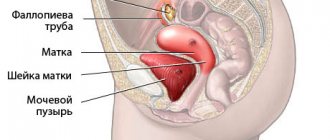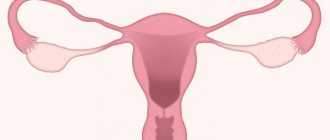The fallopian tubes, also known as the oviducts, are two thin long processes that extend from the uterus on both sides and reach the left and right ovaries. Together with the ovaries, the tubes make up the uterine appendages, in which inflammation the diseases are called salpingitis (tubes), oophoritis (ovaries), inflammation of the appendages (salpingoophoritis, adnexitis), hydrosalpinx. In recent decades, the problem of infertility has become very urgent. Moreover, primary infertility is often registered in young girls, women under 30 years of age, who have not previously had an abortion, have not undergone any operations, and who seem to have had no serious illnesses. One of the most common causes of infertility is obstruction of the fallopian tubes, the treatment of which is most often difficult and only with the help of laparoscopy of the fallopian tubes, surgery to restore them, or IVF can a woman achieve the desired pregnancy (read about pregnancy after laparoscopy).
The role of the fallopian tubes in conception
In one of the ovaries, every month in a healthy woman, a dominant follicle matures; during ovulation, approximately in the middle of the cycle, when the follicle ruptures, an egg is released, giving rise to a future pregnancy. From the ovary, the egg must enter the fallopian tubes and move along them towards the uterus. At this time, sperm from the vagina rush through the cervix, the uterus itself to the fallopian tubes towards the egg, where they must fertilize it. After this, the egg already becomes an embryo and continues its journey through the tubes to the uterus, this period is usually 7-10 days. If fertilization fails, the egg dies and is resorbed within 24 hours. Therefore, the fallopian tubes play the most important role as transporters that deliver the egg to the uterus. The length of the fallopian tubes is almost 10 cm, and the diameter is only 1 cm, and the internal canal of each tube is only from 0.1 cm to 1 cm (narrow at the entrance to the uterus, wider at the ends of the pipe). However, this is quite enough for microscopic eggs and sperm to move freely in them.
Methods to combat tubal infertility
If the causes of tubal infertility are functional disorders, then to eliminate them they resort to conservative treatment, during which nervous tension is relieved and hormonal levels are restored.
Partial obstruction can be treated by laparoscopy. If there is complete obstruction, all these measures do not work. The only effective way to experience the joy of motherhood in this case is in vitro fertilization (IVF), which can be carried out professionally at the Baltic Institute of Human Reproductology. During IVF, the fallopian tubes are not used at all, so their condition does not play any role. The egg is fertilized by a sperm in a test tube, and then the embryo is implanted directly into the woman's uterus. print version
What is the danger of fallopian tube obstruction?
In cases where both or one tube is blocked, inactive, rigid, or the mobility and function of the cilia (villi, fimbriae) that direct the egg into the fallopian tube is impaired, pregnancy cannot occur. Tubal obstruction does not pose a threat to a woman’s health, but is one of the most serious problems with conception and the cause of tubal infertility. Today, clinical data states that 15% of married couples face the problem of infertility due to the fault of the woman and 20-25% of this number belongs to problems with patency of the fallopian tubes. Moreover, with various abnormalities, dysfunctions of the uterine appendages, with partial blockage of the tubes or an inflammatory process in the appendages, a very serious complication is an ectopic pregnancy, which can deprive a woman of one of the fallopian tubes.
Test for tubal patency: price
The cost of diagnosing tubal patency depends on the chosen method. Only your attending gynecologist can determine which method is optimal in your particular case. In general, the price of the study consists of the cost of the intrauterine catheter (which, in turn, depends on the manufacturer, the price of the echo contrast gel), the cost of consumables and the cost of the specialist’s work. The price is also influenced by the geographical location and prestige of the clinic. In Moscow, the average cost of diagnosing tubal patency varies from 1,500 to 4,500 rubles.
The main causes of obstruction of the fallopian tubes
It should be noted right away that the concept of obstruction includes several pathological conditions:
- complete obstruction of the pipes;
- one impassable pipe;
- adhesions around the uterine appendages;
- partial obstruction - since the movement of the egg occurs due to contraction of the tube, in various pathological conditions its contraction is disrupted and the transportation of the fertilized egg becomes difficult, sometimes leading to an ectopic pregnancy;
- disruption of the activity of villi, fimbriae, which are not able to capture the egg and direct it into the fallopian tubes.
Inflammatory diseases of the uterine appendages
Any inflammation of the uterine appendages can occur both acutely and latently, with few symptoms, especially with such hidden sexually transmitted infections as chlamydia in women, ureaplasmosis, mycoplasmosis, cytomegalovirus infection, etc. In acute processes, treatment is carried out in the hospital with antimicrobial, anti-inflammatory drugs, then long course of recovery, resorption therapy. But with hidden infections, the process is not noticeable. During the proliferation of bacteria, their waste products, mucus, and pus fill the narrow passages in the fallopian tubes. If timely treatment and resorption therapy are not carried out, adhesions and scars remain on the thin sensitive walls, which leads to partial or complete obstruction.
Tuberculosis of female genital organs
Many sources of medical literature indicate that tuberculosis very rarely affects the genitals and is considered an uncommon cause of infertility. However, today the decline in the level of health of the nation, the decline in immunity among the population, as well as the resistance of Mycobacterium tuberculosis to drugs leads to the fact that many chronic patients who cannot be treated, as well as unexamined citizens, live in cities. Infection and morbidity among children is becoming very high. And almost the entire population becomes infected with Koch's bacillus before the age of 15-20, and the disease can manifest itself years or decades after infection. It should be borne in mind that the insidiousness of this disease is that it affects not only the lungs, but also any organs of the human body and proceeds oligosymptomatic, and extrapulmonary forms are extremely difficult to diagnose. When a girl is infected during the period of growth and formation of the genital organs, tuberculosis can lead to abnormalities in the development of the uterus and appendages, hormonal imbalance, underdevelopment of the mammary glands (hypomastia), complete obstruction of the fallopian tubes, and impaired ovarian function. The insidiousness of this infection also affects that after infection, the immune system copes with the mycobacterium and the foci of inflammation subside on their own. And with a decrease in immunity, with severe exhaustion, excessive dieting, severe stress, during puberty or hormonal changes, very often after childbirth, a relapse may occur again. Moreover, an X-ray of the lungs in a girl or woman may be normal. In Russia today, medicine turns a blind eye to the existing problem of the epidemic of tuberculosis and its drug-resistant forms. Diagnosis of extrapulmonary forms of the disease is at an extremely low level, but many women could successfully become pregnant if tuberculosis was detected in time and treated efficiently. Anti-tuberculosis services in the regions of the country are very limited in funding and even when a person applies for diagnosis, except for Mantoux, Diaskintest , and x-rays (excluding only pulmonary tuberculosis), no thorough diagnostics are carried out in cities far from Moscow and St. Petersburg, and there are not enough qualified TB gynecologists. But tuberculosis of the female genital organs is often of a latent, sluggish nature, sometimes giving false negative culture results (1 positive out of 3 negative). If a woman constantly (or periodically in the second phase of the menstrual cycle) has a low-grade body temperature of 37-37.5, weakness, allergic reactions, increased sweating, chronic salpingitis or salpingoophoritis, menstrual irregularities, tests for hidden infections give negative results, persistent infertility due to obstruction of the fallopian tubes, there may also be hypoplasia of the uterus (“baby uterus”) and the treatment is not effective - doctor should recommend being examined in an anti-tuberculosis gynecological department (preferably in St. Petersburg or Moscow) to exclude or confirm tuberculosis of the female genital organs.
Other reasons
- operations in the abdominal cavity or pelvic organs - removal of appendicitis if it ruptures, intestinal surgery, abdominal trauma, peritonitis, adhesions formed after any surgical intervention in the abdominal cavity;
- endometriosis
- abortions (complications), intrauterine manipulations, hydrotubation of the fallopian tubes;
- ectopic pregnancy in the past;
- congenital anomalies of the fallopian tubes;
- tumors or polyps of the fallopian tubes.
The risk of developing fallopian tube obstruction due to inflammation according to clinical observations is:
- after 1 episode of inflammatory process in the uterine appendages, the risk of fallopian tube pathology is 12%;
- after 2 episodes – 35%;
- after the 3rd inflammatory process - 75%.
If a woman experiences acute, aggressive inflammation of the uterine appendages, it may be necessary to remove both or one fallopian tube and, of course, pregnancy naturally becomes unlikely or impossible. How to treat tubal obstruction? Today, such a progressive trend in reproductive medicine as IVF gives all women a chance to experience the joy of motherhood even in the absence of fallopian tubes.
Diagnosis and treatment
The main diagnostic tool has long been an ultrasound examination of the abdominal cavity or, more familiar to the ear, ultrasound. In most cases, ultrasound is sufficient to diagnose the problem, especially with the intravaginal method of inserting a diagnostic device. Using ultrasound, you can determine swelling of the fallopian tube, the presence of adhesions or neoplasms1.
Another effective method is endoscopy. A special fiber optic tube with a camera at the end is inserted into the uterine cavity and moves towards the fallopian tubes. Any pathological changes are recorded on a separate monitor4.
A less common method, but especially popular if obstruction is suspected, is hysterosalpingography (HSG). A special contrast agent is injected into the uterine cavity, after which an x-ray of the abdominal cavity is taken. In the image, the uterus is immediately completely visible, and areas of complete obstruction of the tubes are easily identified1.
In addition to the basic methods, doctors take blood, urine and vaginal smears for a general analysis. Typically, the diagnostic process takes place in a gynecologist’s office, but if necessary, a neurologist, oncologist, infectious disease specialist and endocrinologist can be involved in the process.
The choice of treatment method depends entirely on the cause of tubal obstruction and the extent of the lesion2:
- Drug treatment is prescribed for the progression of infectious processes or other failures. The doctor prescribes a specific drug - antibiotics, antiviral drugs, immunostimulants, hormonal drugs and much more.
- Physiotherapy is used after defeating the infection and as a preventive measure. As part of physiotherapy, special baths, massage, electrophoresis and myostimulation are used.
- Surgical treatment is the most effective method and the only one in the presence of adhesions or tumors. Typically, a gentle and modern method of surgery is used - laparoscopy.
If no treatment method produces results, then a diagnosis of infertility is made and the woman should pay attention to artificial methods of insemination. In most cases, the uterus is still functioning, and obstruction of the fallopian tubes is not a contraindication to pregnancy.
Womenfirst
- Abashidze, A. Methods of rehabilitation of reproductive function in women with tubo-peritoneal infertility / A.A. Abashidze // Medical and social examination and rehabilitation – 2014 – No. 2 – pp. 42-46.
- Yakovleva, E. Ways to restore the functional activity of the reproductive organs of women after inflammatory diseases / E.A. Yakovleva // Scientific Gazette - 2013 - No. 25 (168) - Issue 24 - P. 66-72.
- Ayushinova, N. Assessment of the severity of adhesions in the abdominal cavity / N.I. Ayushinova, I.A. Shurygina, M.G. Shurygin, E.V. Glinskaya // Siberian Medical Journal – 2014 – No. 7 – P. 10-14.
- Yakovleva, N. The importance of endoscopic technologies in the diagnosis and selection of treatment methods for patients with tubo-peritoneal infertility / N.V. Yakovleva // Mother and child in Kuzbass - 2013 - No. 2 (53) - pp. 31-37.
- Dubinskaya, E. Pelvic peritoneal adhesions (endoscopic characteristics) / E.D. Dubinskaya, A.S. Gasparov, S.K. Nazarov, M.F. Dorfman // Bulletin of RUDN University, Medicine. Obstetrics and Gynecology, – 2010 – No. 6 – P. 166-173.
RUDFS183119 dated 10/03/2018
Symptoms, signs of tubal obstruction
If the fallopian tubes are obstructed, there may be no symptoms or signs; this pathology may not affect the general state of health and well-being in any way. There are cases when a young woman uses contraception in order not to become pregnant during periods of life when they are not planning to have children, and when the desire to have a child comes, the absence of pregnancy and the diagnosis indicated serious problems with the fallopian tubes. This happens, unfortunately, not uncommonly . The woman did not even know about such a pathology, because there were no symptoms of obstruction of the fallopian tubes and no serious health problems either. However, with chronic recurrent inflammatory diseases, as well as with hydrosalpinx, many women experience the following signs of tubal obstruction, which can occur with other pathological processes of the female genital organs:
Hysterosalpingography images
The right fallopian tube is obstructed in the ampullary section.
The left fallopian tube is freely patent.
The "R" on the image indicates the patient's right side.
The arrow indicates an obstruction in the ampullary section of the right fallopian tube.
The right and left fallopian tubes are difficult to pass due to the presence of bilateral valve sactosalpinxes.
The image clearly shows dilated and tortuous fallopian tubes.
The arrow shows the fallopian tube on the left with the presence of a valve sactosalpinx.
The "R" on the image indicates the patient's right side.
The left fallopian tube is freely patent.
The right fallopian tube is obstructed in the intramural section.
The arrow indicates the presence of an obstruction at the mouth of the right fallopian tube.
The letter "R" in the image represents the patient's right side.
The left fallopian tube is obstructed in the ampullary section.
The right fallopian tube is difficult to pass due to the presence of a valve sactosalpinx on the right.
The arrow shows the valve sactosalpinx on the right.
The "R" on the image indicates the patient's right side.
How to determine, how to check for obstruction of the fallopian tubes - diagnostics, examinations
If a man’s spermogram is normal, and a woman has regular ovulation, a normal structure of the genital organs, and no signs of inflammation, the most likely cause of infertility is obstruction of the fallopian tubes. In this case, additional instrumental diagnostic methods are indicated.
Hydrosonography (echohysterosalpingoscopy) or ultrasound determination of fallopian tube patency
It is clear that conventional transvaginal ultrasound cannot determine the patency of the tubes. But a special UZGSS can give a general conclusion about whether the pipes are passable or not. The disadvantage of this diagnosis is that it is not an accurate method, unlike diagnostic laparoscopy or HSG. However, this is a very fast and low-traumatic method that does not require anesthesia, surgery (as with laparoscopy), or radiation exposure (HSG), so the study is safe and can be performed several times. Hydrosonography occurs in this way - before the procedure, the doctor enters the cavity The uterus injects a sterile saline or other solution in order to straighten the walls of the uterus and make them more visible on ultrasound. After this, the doctor determines where the injected fluid flows. With tubal patency, fluid flows from the uterine cavity into the tubes, and then into the abdominal cavity, and a specialist can see this using an ultrasound. If the fallopian tubes are obstructed, the uterus will stretch and its cavity will expand. However, in case of partial obstruction, adhesions, or other pathologies, it is impossible to clearly see the picture of the condition of the pipe using this method.
HSG – hysterosalpingography, x-ray of the uterus and tubes
This method of checking the patency of pipes is more informative than hydrosonography, but in recent years it has been used much less frequently than before. For diagnosing tuberculosis of the female genital organs, this method is the most informative. The essence of the procedure is as follows: after local anesthesia, the doctor injects a contrast agent into the uterine cavity and takes several x-rays after a certain time. The images will show clear contours of the uterus, then, as the fluid moves through the pipes, the fallopian tubes will be visible, as well as the flow fluid into the abdominal cavity due to patency of the tubes. If the fluid stops in any part of the pipe, the doctor can record its obstruction. This procedure should be carried out in phase 1 of the menstrual cycle to avoid irradiation of the egg. Many doctors find this method to be somewhat therapeutic, since the injected solution has a washing effect. However, today this diagnostic method has begun to be used less frequently also for the reason that this procedure should only be performed by an experienced doctor, and it also does not always bring reliable results (in 15-20% of cases there may be false results) when, due to a spasm of the tube, the contrast the substance does not enter the pipes. In addition, HSG harms women's health due to radiation, can cause exacerbation of salpingitis and causes pain after the procedure. Then the doctor has to repeat the test or use other diagnostic methods. HSG also cannot diagnose ovarian adhesions and endometriosis.
Diagnostic laparoscopy
Today this is one of the most popular, informative, accurate methods of not only diagnosing, but also treating female infertility. With this method, not only tubal obstruction and signs of fallopian tube obstruction are detected, but also other causes of infertility, such as endometriosis, ovarian cysts, polycystic ovary syndrome, etc. The advantage of this method is the accuracy of the results and the ability to eliminate some disorders - adhesions are cut, lesions are cauterized endometriosis. In order to determine if the fallopian tubes are blocked through the cervix, the doctor injects a solution that penetrates the tubes and then into the abdominal cavity.
Fertiloscopy and transvaginal hydrolaparoscopy
Transvaginal hydrolaparoscopy is an examination of the condition of the female genital organs using a video camera, as with laparoscopy, only through a small incision in the vagina. Often this procedure is performed together with chromohydroturbation, hysteroscopy and salpingoscopy, then this study is called fertiloscopy. To determine the causes of infertility, both fertiloscopy and transvaginal hydrolaparoscopy are as effective as conventional laparoscopy, only they are less traumatic and do not cause complications.
Doctors
- Terekhova
Lyudmila Alexandrovna - Gynecologist-endocrinologist
- Highest category
- 37 years of experience
More details
- Krupenkina
Lilia Alexandrovna - Ultrasound diagnostics doctor (ultrasound)
- Highest qualification category, candidate's degree
- 29 years of experience
More details
How to treat tubal obstruction
All of the listed methods for diagnosing tubal patency can be erroneous, not 100%, so do not despair, a woman always has a chance of becoming pregnant if she has a uterus and at least one tube and an ovary. You can use modern methods of anti-inflammatory, absorbable therapy, as well as laparoscopy and IVF. Tubal obstruction causes only 25% of all cases of infertility; in all other situations, the inability to conceive is caused by endometriosis, ovarian dysfunction, ovarian cyst, polyps in the uterus, uterine fibroids, immunological incompatibility partners (that is, a woman’s allergy to her husband’s sperm), as well as pathological disorders in the man’s body, or simultaneous problems in both partners. When tubal obstruction is determined, before starting any treatment, the attending physician must make sure that this is the only underlying cause problems with conception, and not a complex of other disorders in a woman and her man. A standard comprehensive examination of a married couple is as follows:
- whether the woman ovulates regularly;
- determination of a woman’s hormonal balance;
- condition of the uterine mucosa;
- analysis of the quality of the husband's sperm - spermogram (how to take it, results).
If it is determined that the woman produces follicles regularly, the menstrual cycle is not disrupted, the hormonal levels are also normal, the uterus is able to support the development of the fetus, the man has normal sperm quality, and instrumental methods diagnose obstruction, then experts can recommend conservative and surgical treatment.
- conservative is a course of anti-inflammatory therapy when an inflammatory process of the uterine appendages is detected. It consists of: a course of antibiotic injections, a course of Longidase injections, physiotherapy (electrophoresis with absorbable drugs that improve local blood circulation). This will be effective if treatment is carried out no later than 6 months after adnexitis and when a pronounced adhesive process has not yet developed;
- Surgical treatment to restore tubal patency is indicated for women under 35 years of age with regular ovulation in cases of partial obstruction.
And even such serious measures cannot guarantee success, since there is a high probability of developing an ectopic pregnancy, and restoration of tubal patency may not be enough if the activity of the fimbriae is impaired, or if the contraction of the fallopian tubes is impaired.
A woman after tubal surgery in the future, if the pregnancy test is positive, should immediately consult a doctor to find out the location of the fertilized egg. Because after inflammatory processes and surgery, the risk of ectopic pregnancy increases 5-10 times.
In cases where several types of different diagnostics confirm complete obstruction, a woman who wants to have children should not waste time on various types of treatment for obstruction of the fallopian tubes, but prepare for IVF. Today, this procedure is becoming more and more accessible both in terms of price (no more than 150 thousand rubles with all tests and diagnostics), and in terms of a large number of accessible centers with experienced specialists and equipment for performing the operation. In doubtful cases or when the patency is impaired in one of the tubes, it is possible to use laparoscopy to eliminate, if possible, existing disorders, obstructions and adhesions. Such operations themselves do not guarantee either conception or the normal course of pregnancy, since the presence of a lumen does not mean at all that the egg can move along them. Therefore, it is important to carry out further physiotherapeutic, resolving treatment, as well as eliminate possible disturbances of the menstrual cycle and hormonal levels. In case of infertility due to obstruction of the fallopian tubes, the choice of treatment also depends on the age of the spouses, the degree of damage to the tubes, additional factors of infertility of the man and woman, as well as financial capabilities of the couple. Nevertheless, IVF is recognized today as the most effective, not very expensive and more successful, reliable method:
| ECO | Surgery | Operation |
| Efficiency of the method | for women under 35 years old 60% | for women under 35 years old in unadvanced cases 40-70% in advanced cases 15-20% |
| Risk of ectopic pregnancy | 1-3% | 25-30% |
| Success or failure becomes known | In 2 weeks | during a year |
The path to pregnancy
At the initial stages of the development of adhesions in the tubes, conservative treatment may be recommended - anti-inflammatory and physical therapy. If the adhesions have already become full-fledged masters of the situation, experts recommend surgical treatment, namely, an operation called “laparoscopy.” This is a minimally invasive operation during which the surgeon cuts through the adhesions and restores the patency of the fallopian tubes. Laparoscopy may be effective if the adhesions are around the tubes. In the case where the adhesive process has spread inside the pipes and significantly deformed them, the treatment is unlikely to lead to the expected results. It is advisable to remove the affected pipes to avoid irreversible consequences for the woman’s health. It would seem that it sounds disappointing, and you can forget about pregnancy. This is wrong! If treatment does not help, and especially if the fallopian tubes are removed, pregnancy is possible with the help of IVF. The absence of fallopian tubes is an absolute indication for IVF and the success of the program is very great.
Take the first step - make an appointment!
or call 8 800 550-05-33
free phone in Russia
Fallopian tube obstruction - folk remedies
What is the use of all folk remedies for the treatment of obstruction of the fallopian tubes - the use of herbal remedies, medicinal plants in the form of tampons, douching, ingestion of infusions and tinctures. A woman must understand that if the fallopian tubes are blocked, such methods are unlikely to be effective, and precious time will be lost. For example, a medicinal plant such as Borovaya uterus cannot be used for conception if the tubes are blocked (see Indications for the use of the herb Borovaya uterus), since the likelihood of ectopic pregnancy increases, although in case of infertility for other reasons it is recommended as a folk remedy. And such a method as douching is recognized by gynecologists as a rather unsafe means of self-medication, fraught with the development of vaginal dysbiosis, increasing the risk of developing inflammatory diseases of the genital organs and the risk of damage to the vagina , bladder, cervix. (see How to do douching and whether to do it at all). Any medicinal herbs are the same medicines as pharmaceutical drugs, with possible toxic effects, side effects and contraindications, moreover, in our age of abundance of allergic diseases, in the presence of allergic rhinitis or allergic cough, hay fever, bronchial asthma, herbal preparations can cause severe allergic reactions.
Different types of pathology
Doctors distinguish several types of fallopian tube lesions. The main type is the number of pipes affected - one or two. A lesion in one tube is called a unilateral lesion. Two pipes – bilateral damage. Closing the lumen of one tube significantly reduces the chances of conception, but the possibility remains. With bilateral damage, pregnancy is impossible.
Further, obstruction is characterized by the degree of closure of the lumen - complete or partial3:
- With partial obstruction, the lumen is narrowed, but is still present. The egg, due to its relatively large size, squeezes through with difficulty or gets stuck, which can lead to an ectopic pregnancy when smaller sperm from the uterus penetrate the fallopian tube.
- Complete obstruction means that the egg cannot move and sperm cannot enter the fallopian tube from the other side. A state of infertility occurs.
Overlapping of the lumen can be formed in different parts of the fallopian tube. The thinnest area is the most sensitive - the isthmus. Even mild inflammation of the mucous membrane of the fallopian tube can lead to its complete closure. The most stable area is the funnel, due to its largest width. It can also be blocked, but in extremely rare cases due to congenital pathologies or injuries3.
The reasons for closing the lumen in the tubes are divided into functional and anatomical. With functional obstruction, the main detrimental effect is on muscle motility and the properties of the mucous membrane of the fallopian tube. The movement of the egg is too slow or completely absent. Anatomical obstruction is characterized by the presence of adhesions, trauma, or the consequences of surgery1.









